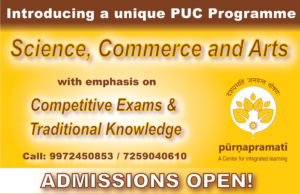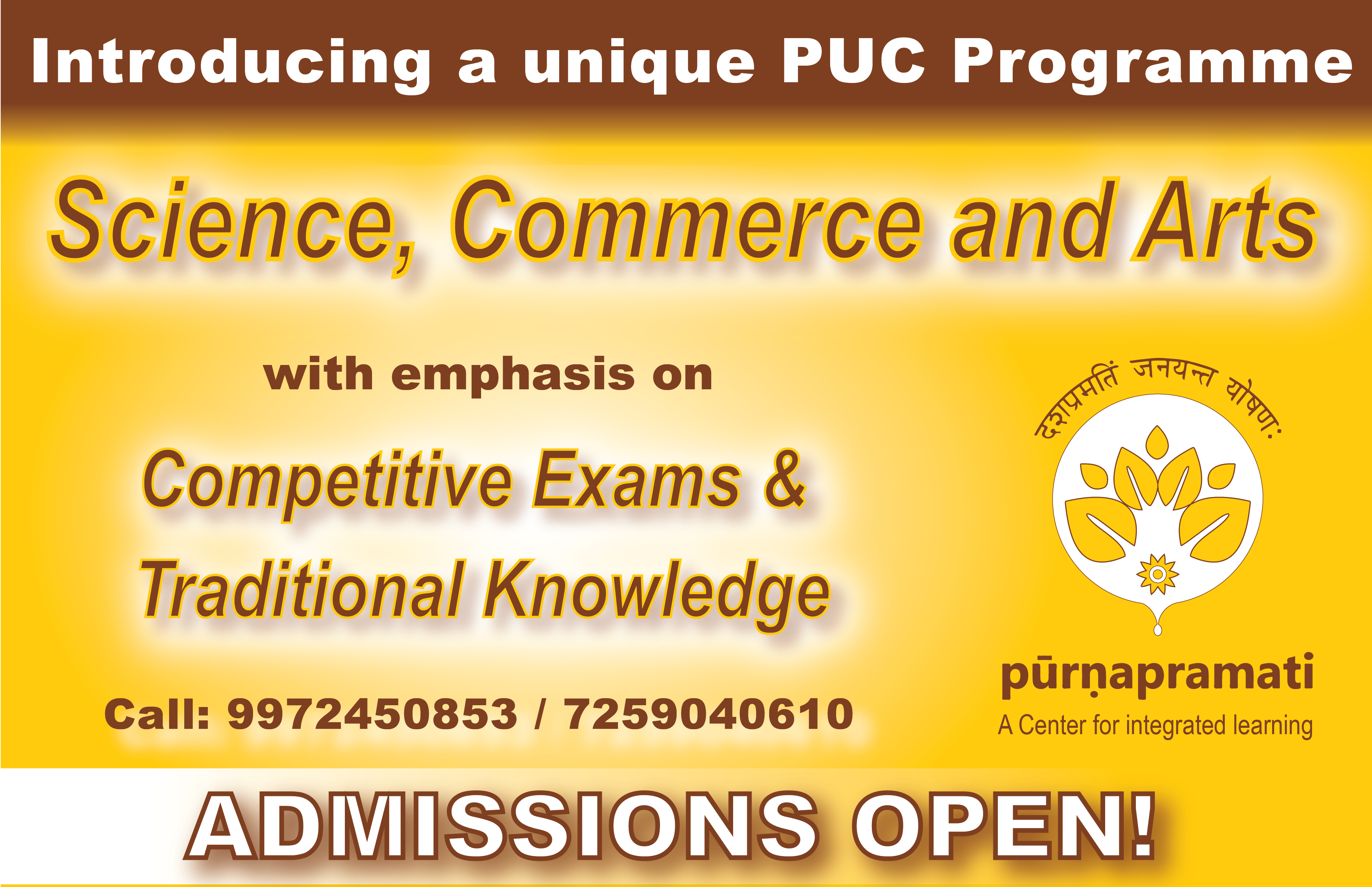Recent Updates
Subscribe
Perspectives on Purnapramati as an Organization
Dr. Madhusudan Atre
Former President and MD, Applied Materials India
Vegashakti Consultants, Nurturing Success
“Purnapramati – A Center for Integrated Learning” is a school which is different from most of the other schools.
It aims to integrate the modern school system of education with the traditional Indian values and knowledge. A holistic grooming of children, from their initial years, is envisaged – helping them to be armed with the modern knowledge base built on the foundations of classical Indian learning – and all this from the early stages of primary school.
Being different also brings its excitements and challenges on various fronts – some of which are Infrastructure, Organization and its Structure, Management & Leadership, Teachers, Success Factors, Criteria & Metrics to measure success, etc.
Being different also has the advantage that one can address the various aspects and challenges in one’s own way, rather than through established means. This gives an opportunity to establish path-breaking and pioneering methodologies in the education system addressing integrated learning.
Some thoughts, as well as pointers, on some of the organizational topics are presented below (the list is not prioritized, all of them are important):
1. Learning from Others: There have been other schools and educational institutions (at various levels from school to universities) which have also addressed holistic learning. It is important to understand what successes and challenges they have faced, and learn from them. Take the positives, and keep in mind the areas of improvements.
2. Organization: It is very important to set up a proper organization structure. The proper requirements need to be identified – Trust Board, Governing/Advisory Board, Executive Team, Operational Team, etc. It is critical to have clearly defined positions, along with well defined roles and responsibilities, reporting, performance appraisals, etc.
3. Strategic and Tactical: Keep in mind the important aspects of Vision, Mission, Core Values, Goals, and Roadmaps – and enable their success from the very beginning by setting up the right environment and platforms. The long term strategic goals should be the guiding stars, and the short term tactical roadmaps should be the achievements.
4. Empowerment & Accountability: Each role and position has to be empowered to do the job, and properly balanced with accountability towards doing the job. The system should be based on meritocracy – and is applicable for all people within the organization, whether they are teachers or directors or advisors or trustees.
5. High Standards: The aim and vision should be for the highest standards of quality, outputs, team, etc. It is important to aim for the galaxies, so that one can at least reach the sun and the moon.
6. Organization v/s Individual: While it is important for each person within the organization to contribute his/her best and be successful, it is important to keep in mind that Organization comes before Self. “Silo – Mentality” should not be encouraged. It is indeed true that “an individual succeeds when the organization succeeds”, and not the other way round. Team work is the key.
7. Success Factors: Along with accountability comes the need to define success and measure it. Suitable metrics and criteria need to be defined and put in place. All the people in the organization must realize what the organization expects of them to be successful, and how they will be held accountable.
8. Organizational Culture: The culture of an organization will ultimately determine its future in the long run. Focusing on – transparency (balanced with a “need to know” approach), honesty, stress on ethical behavior and high value system, and “walking the talk”, etc – will set the tone of the organizational culture for the future.
9. Evolving Strategy and Adaptability: While it is important to have goals, vision, strategy – it is equally important to realize that while the many goals will be achieved with time; the world and ecosystem will change, the needs will evolve, etc. Hence the goals should be studied at suitable frequencies, and adaptability towards change should be kept in mind.
10. Ecosystem: Many ingredients go towards making this organization – teachers, parents, children, society, management, school infrastructure, etc. It is important to ensure that all are in sync. Hence communication at the right levels of frequency and content, as well as involving the various ingredients at the right time place and place will add to the success. The commitments, and passion, of the entire ecosystem is important.
11. Self Improvement: As the organization grows and successes come in – reflecting on what has gone well, as well as what could have been done better, is important. This will help achieve future successes in quicker time, as well as avoiding pitfalls and obstacles in the future.
There are, surely, many more. The attempt here is to highlight some of the aspects which are important in a new organization which is starting to grow, and trying to reach the next (and higher) levels.
Being a “start-up” in terms of the age of the organization, may have some additional aspects to consider.
1. Founding Principles Towards a Long Term Success: All of the aspects of general organizational success mentioned in the 11 points above are also relevant for a new “start-up” organization.
2. Entrepreneurial v/s Structured Organization: The philosophies of organizational behavior in a new start-up are very different from a big, established organization. In a start-up – the approach is informal, everyone does anything to make things successful, roles are ambiguous and cut across individuals, etc. In an established organization – there are systems and processes, roles and responsibilities are well defined, there are clear accountabilities, etc. It is important to find the right balance, such that the dynamism and entrepreneurial approach of a start-up, mesh as seamlessly as possible with the structured and process approach of an establishment. And the degree of the two approaches can vary with time.
3. Establishing Credibility: Being a start-up, it is very important to establish credibility – as this will determine the success for the future. Having specific goals and targets, regularly measuring against these goals, frequent communication on the status to the stake holders (teachers, parents, management), delivering to the commitments, demonstrating the value-add, explicitly showing the sustained differentiation of the value-add, etc go a long way. It is important to identify who the “customers” are (parents? students? management?), find out what their expectations are, make commitments, and deliver against the commits.
4. Communication: Unlike an established and well-known organization, a start-up needs to build its brand. While setting goals, identifying timelines, outlining roles and responsibilities, achieving results, etc are all very important – it is important for all the stakeholders (students, teachers, management, trustees, society, advisors, etc) to be kept informed. This has to be regular and specific, and should demonstrate the results vis-a-vis the set goals and targets. This is a very important aspect of setting credibility.
5. Success Criteria: An important aspect of analyzing, and measuring, success is to define the criteria of success. For a school in its efforts to establish a new approach to Integrated Learning – the relevant metrics need to be defined by the management. Some of these could be – growth in the number of parents seeking admissions for their children, reduction in the number of drop-outs, increasing number of teachers seeking employment, getting recognized as “one of the best” schools, increasing media coverage and brand recognition, becoming a role-model for other schools to emulate, unsolicited feedback from the parents/children on the value of Integrated Learning, etc.
6. Focus and Staying Power: There will be multiple challenges in a start-up, big and small. Once the strategic and long term goals and vision are set, it is critical to stay focused in the face of hurdles. Many exciting possibilities, options, and challenges will surface – some good, some which will be distractions. Carefully treating each on its merit is the key. The vision and goals will be the “pole star”, and will help to stay focused and achieve the desired results. Since any new and different venture takes time to succeed, staying power is important, and to ensure there is no burn-out – this is where the advisors and “external” thought leaders can help bring a stabilizing perspective, since they can help to not “miss the forest for the trees”.
The efforts, the time, the energy, the thoughts, the passion, the commitment, put in by all the concerned people to start and grow Purnapramati is highly commendable. This is a team with a vision, and a desire to make an impact on society. No less a role has been played by the children, the parents of the children, and the teachers.
Once Purnapramati has set its roots in the ground and started on its path, the trunk and branches need to grow tall and spread out – thus giving shelter to the needy. Once it has attained strength and stature in its initial vision, it needs to mimic the Banyan Tree – grow branches far wide which then drop down to the ground to form new trunks of trees. This will enable the message of Integrated Learning, and the benefits of this education system, to spread far and wide.
Here is giving appreciation, and thanks, to all who those have embarked on this wonderful journey.
Wishing Purnapramati, and its team, all success for the future. Good luck.
Source: ಊರ್ಧ್ವಮೂಲ Purnapramati Souvenir 2012














